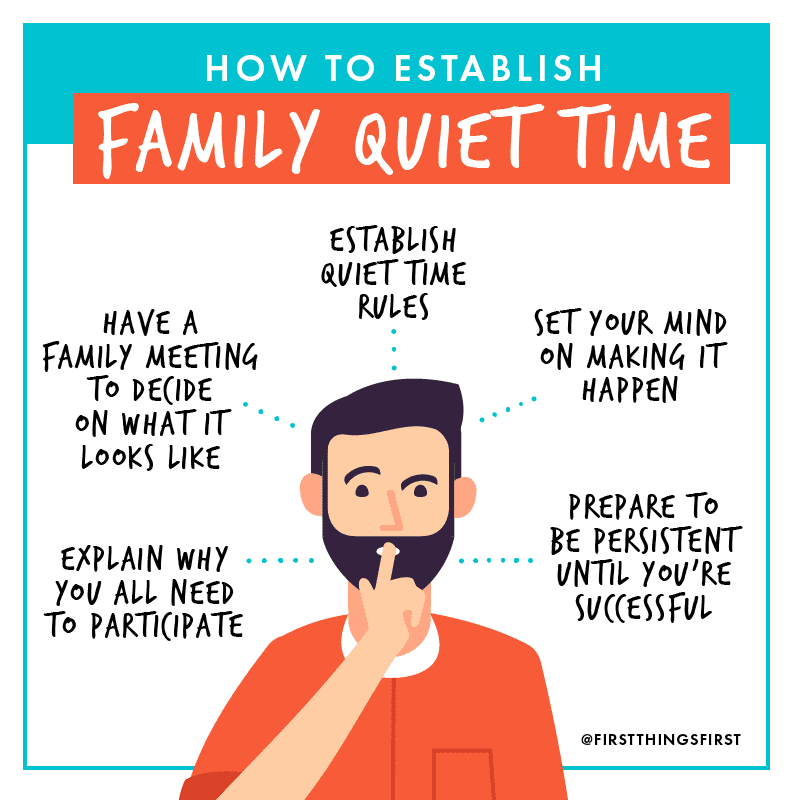How to Establish a Family Quiet Time

Some people saw How to Establish a Family Quiet Time and thought, “Yeah right. There’s just no way. You haven’t been to my house. You don’t know my kids.”
I am just one of the latest work-at-home dads who is amazed at just how much activity, noise, and energy can be expended by my co-inhabitants. Who are the co-inhabitants? Two daughters (7 & 13), 5 sons (ages 5 months – 11 yrs), 1 wife (can’t put her age, it’s a violation of the code). That’s eight other people. Noise is the default. Not having some quiet time is not an option either. Otherwise, I’m really gonna lose my mind.

I’m not going to try and convince you on the importance of quiet time. I haven’t met a parent yet who doesn’t crave it when they are home all day with their children. I’m just going to empower you to establish a quiet time.
Step 1: Get Your Mind Right.
You’ve got to believe it can be done. They may resist and scream. They may dig deep into their bag of tricks to block the entry of a quiet time into your home. Don’t believe the lie. They don’t know what’s good for them. Hear the voice of the man with 7 kids: “It can be done. You can do it.” It may not be perfect the first time, but whatever you do, don’t believe the lie. Which takes us to step #2.
Step 2: Prepare To Be Persistent.
If at first you don’t succeed, try, try again. You didn’t ride your bike perfectly the first time you took off the training wheels. They don’t believe that you’re serious unless you stick with it. Kids are wired to resist anything that their parents say is good for them at first, at least it seems that way. It’s not impossible just because it didn’t work out the first time. You’re going to have to stick with it.
Step 3: Family Meeting.
Gather the troop together and tell them, “Each day, we are going to have some quiet time in this home. It helps our minds to relax and our bodies to rest. You may not think you need it, but I, as your parent need it and your body will thank you for it. There is no room for negotiation on the fact that there will be a quiet time. You may negotiate what can be done during quiet time.”
Step 4: Explain Why Their Quiet Time Is Your Productive Time.
In order to get more of the ‘me’ you like later, I’ve got to get done what I can now so that we can enjoy one another later.
Step 5: Establish Quiet Time Rules.
Acceptable activities during quiet time: Sleep, lay in bed, read, write, meditate. Prohibited activities include: Video games, calling/texting with outside people, playing with siblings. Quiet time is as much about your mind being quiet as it is simply taking a nap.
Note: Play that is not noisy and only involves one person is acceptable for my seven and up crew. For instance, my 7 year old may sit on her bed and play with her dolls for a full hour. My 9 year old may sit on his bed and build legos. My instructions to them, “I should not hear you. I should not see you. You should not need to ask me anything.” If they ask me something about the legos or the dolls, they are automatically prohibited from playing with them during quiet time.
Step 6: Establish When And How Long.
Routines and Consistency is the name of the game. If your children had quiet time at school, schedule family quiet time at a similar time. Schedule quiet time around the same time each day. In our house, our routine is lunch at 12:00, play outside til 1:30, quiet time 1:30-2:30. For our kids under 7, that normally means a nap or at least laying in the bed. The others – read, nap, write, build something. The key- they are in a space all to themselves and need no attention. (Note: You may start at 30 minutes as opposed to an hour. And no, we don’t wake the kids up after an hour if they are asleep. Are you kidding me?)
Optional: Set a timer in their room. You don’t know how many times my children have fallen asleep looking at the time countdown. I count that as a parental win. Otherwise they like to ask, “Is it time yet?”
Step 7: Set And Enforce Consequences For Quiet Time Violations.
The keys to good consequences are that you have to find out what means most to your child. Then you must be willing to enforce it the first time. This is where having your mind right and believing that it can be done is key. Suggestions: Add time—5 minutes for each violation. Eliminate dessert from dinner. Decrease screen time. Earlier bedtime.
Remember, this may be new for your child. They may not have expected this from you. They are going to test you. Your biggest weapon is enforcing the consequences while staying cool, calm and collected. If you don’t enforce the consequences quickly, then you may get frustrated when they violate the rule again and lead you to believe that it’s a hopeless cause.
Step 8: Implement.
Be firm. Follow your plan. Keep the vision of peace and quiet in front of you. Celebrate the victory, however small it may be at first. Let them know that we’ll all get better at it.
Practical Tips
- Send kids to the bathroom first!
- No eating during quiet time. May give them snacks right before quiet time, but not sugary snacks. Design your schedule for what works best. Kids always want to eat. So decide if they eat before or after and stick with it, but not during.
- Check in on them and encourage them if they are doing good. If they’re asleep, let ‘em sleep.
- Enforce consequences. That’s how they know you mean business.
- Be productive in whatever you decide to do during this time – work, yoga, emails, nap, etc. (Yes, naps are productive.)
Implementing anything new in your family can be challenging, but having a family quiet time is good for your kids and good for you! It might take some time to get it down, but it is definitely worth it!








Thoughts? Leave a Comment